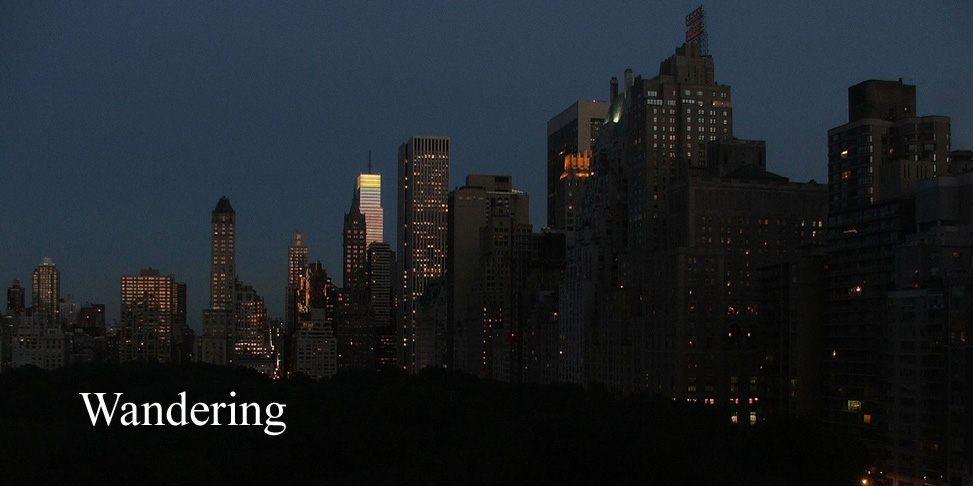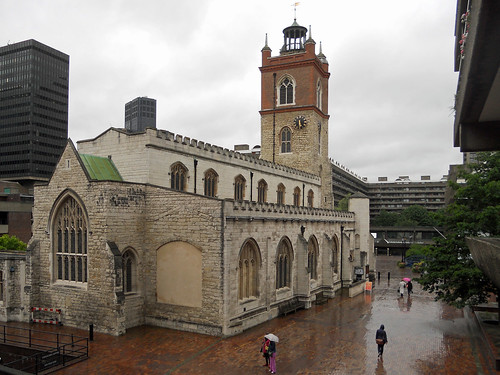
Last
July, I went to an early evening concert given by Ben Johnson, tenor and James
Baillieu, piano at St. Giles Cripplegate.
It was called Postcards from Paris and comprised songs by Poulenc,
Faure, Duparc, Hahn and Lennox Berkeley.
Berkeley was not French but, if I need mention, studied with Nadia Boulanger and spent some time in Paris.
It was a delightful concert which introduced
me to lots of unfamiliar music which I will continue to explore. Before the concert I looked around the church
and found several things of great interest one of which led me to Waseda University
in Japan.
St.
Giles Cripplegate (as it was built outside the city walls actually St.Giles
without Cripplegate), now surrounded by the Barbican redevelopment, is a
medieval church which dates from the 12th century. It was
completely rebuilt in 1390. There was a
fire in 1545:
The xii day
of September at iiii of cloke in the mornynge was sent Gylles church at Creppyl
gatte burnyd, alle hole save the walles, stepull, belles and alle, and how it
came God knoweth.
Following
the fire there was another rebuilding, though some of the 14th century
fabric survives in the walls and base of the tower.
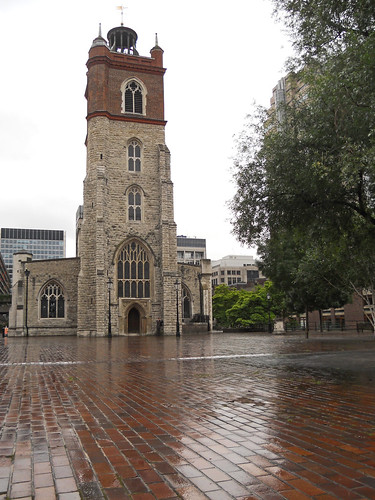

The
red brick section of the tower with pinnacles was added in the 17th
century. The cupola above it was added
as part of postwar restoration, though one of similar design appears in a
picture of the church from 1830.
The
church is situated to the north of the area devastated by the Great Fire of London
in 1666 and was unaffected by it; maps
of the area overwhelmed by the fire, indicate that the city wall close to St.
Giles acted as a firebreak.
There
was further restoration both before and after damage caused by the Cripplegate
fire of 1897. But worse was to come. Only the shell of the building survived enemy
bombing raids in 1940 in which almost all the furnishings were destroyed as
well. The church has published a picturegallery * showing the building before and after this catastrophe.
John
Milton (1608 - 1674), who lived nearby for most of his life was buried in the
church.
Sometime
later, in 1793, a bust by John Bacon the elder was installed. Paradise Lost is remembered in the carving
under the pedestal.


Bacon
has been called the first great sculptor of the industrial revolution. He established a factory-like studio with a
large output. In 1771 The Daily Advertiser stated that
(Bacon’s) merit as an artist was too well
known to need any encomiums.
Milton
does not look at his best in my photograph of the bust. This may be because the picture was taken
with an unsophisticated camera using a basic flash, or because Bacon was no
republican. When invasion from
revolutionary France threatened, he provided his apprentices with weapons and
subjected them to military drill. He
berated a clergyman for mentioning equality.
In
1903 this memorial was joined by a statue of the poet. (The bust to the left in
this photo is of John Speed (1552 – 1629), “Citizen
and Merchant Taylor” who is also buried in the church.) I read that the statue of Milton was added as
part of a campaign to drum up interest in St.Giles during a fund raising drive.
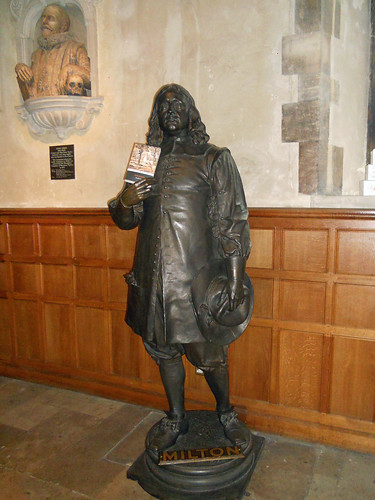

When
I visited, Milton had been provided with a copy of the Penguin edition of
Paradise Lost; and other photos on Flickr show that in the preceding months he
had held a bunch of yellow flowers and at Christmas, a Santa Claus doll. In 2009 he held a toy rabbit linking him with
another literary person, Beatrix Potter.
The frivolity is a new development. When the statue was first proposed the church
Vestry noted that no statue had yet been erected of “one of the greatest poets of this or any other country ...” and
looking to “... a suitable public memorial
to mark local appreciation of his fame.”
The
statue was made by Horace Montford.
Details of his life are hard to find.
He was the father of Paul Raphael Montford (1868 - 1938), also a
sculptor, who travelled to Australia and made many well known statues in
Melbourne. Maurice Grant wrote that Horace was “equally known
as (Paul), he was of equal merit and equal industry showing more than 50 works
in the galleries from 1860 to early in the XXth century”. These works included some subjects taken from
Milton. At the time of his Milton
commission he was best known for a statue of Charles Darwin at Shrewsbury.
The
statue originally stood on a pedestal designed by E. A. Rickards with reliefs
illustrating some of Milton’s works. The bombing raid which devastated the
church knocked the statue off this pedestal and it has never been
restored. Milton’s right hand was
damaged and has since been replaced in fibre glass.
The
Plinth remains outside the church in a much deteriorated condition.
All
attempts to restore the statue to the plinth or a replacement have failed, apparently
due to an arcane dispute about the ownership of the statue and plinth.
As
damage to the church and statue occurred in the first Nazi raid on the City of
London, Milton’s fall was reported around the world.
In
Australia, Ralph E Robson of Mosman wrote to the Sydney Morning Herald:
Sir-The bombing of
this statue in London makes one wonder whether Hitler was contemplating revenge
on the author of “Paradise Lost", realising that London (his coveted
Paradise) can never be captured and is therefore lost to him. Hitler will do
well to ponder over the words of the blind poet who said:-
When God wants a hard thing done in the world.
He tells it to His Englishmen
A prophetic
utterance now in course of fulfilment.
I am. etc..
It’s not uncommon for bursts of
enthusiasm for the famous dead to result in the erection of statues and
memorials; sometimes long after the death of their subject. In this case, however, Milton’s own opinion
was not consulted. He wrote of
Shakespeare:
What needs my
Shakespeare for his honored bones
To labor of an
age in piled stones,
Or that his
hallowed relics should be hid
Dear son of
memory, great heir of fame,
What need'st thou
such weak witness of thy name?
Thou in our
wonder and astonishment
Hast built
thyself a livelong monument.
For, whilst, to
the shame of slow-endeavouring art,
Then thou our
fancy of itself bereaving,
Dost make us
marble with too much conceiving,
And so sepúlchred
in such pomp dost lie
That kings for
such a tomb would wish to die.
|
A fascinating Elizabethan, EdwardAlleyn (1566–1626) is commemorated in a modern stained glass window in St. Giles.
The window was made by JohnLawson (1932 – 2009) of Goddard and Gibbs.
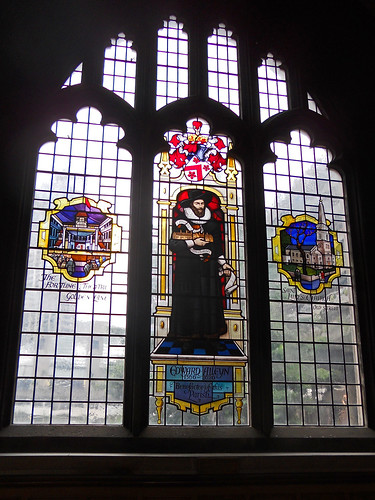

Alleyn was an actor
who at 17 was performing with a touring company the
Earl of Worcester's Men. By his mid
twenties, he was performing with Lord Strange’s men at the Rose theatre. He then became leader of the Admiral's Men and
is best known for his performances in Marlowe’s plays. In, The
World of Christopher Marlowe, David Riggs writes that “...in performing the
role of Tamburlaine, Edward Alleyn became the first matinee idol in English
Drama.”
He became part owner of The Rose theatre, and later
built The Curtain, situated in the
parish of St. Giles. By about 1597 had ceased to act on the stage
altogether. Together with his father in
law Philip Houslow he pursued these and other investments.
In particular, Alleyn and Henslowe attempted, at
first without success, to gain the official post of master of the bears, bulls,
and mastiff dogs. This carried with it a
lucrative monopoly in animal baiting. In
1604 they purchased the patent and between them held the position for many
years. They became proprietors of The
Beargarden, a long standing arena on Bankside near the Rose and Globe theatres. It is
said that Alleyn himself took part in the baiting of bears.
The past is indeed another country. These cruel and disgusting spectacles were popular
with the same crowd who first saw Shakespeare’s plays.
From this and other investments, Alleyn accumulated
significant wealth. He purchased Dulwich
Manor which included large areas of land in and around Dulwich. His philanthropy included the foundation
of College
of God's Gift at Dulwich, gifts to
the poor in the parish of St. Giles and bequests to enable the building of ten
almshouses in the parishes of St Saviour's Southwark (now Southwark Cathedral )
and St Botolph without Bishopsgate.
The design of the window incorporates a
portrait of Alleyn taken from one by an unknown artist held by the Dulwich
Picture Gallery. Above is the family
coat of arms in which I think I can recognise a chevron
between three cinquefoils gules. In his
hands we see a representation of the alms houses. The Fortune theatre is depicted to his right
and to his left, the church of St Luke Old Street.
On its face, this is peculiar as St Luke’s Old
Street did not exist in Alleyn’s day. It
was built in 1733 to relieve St. Giles but later fell into disrepair and was
deconsecrated. It has now been
redeveloped as a music centre by the London Symphony Orchestra. The distinctive tower of St. Luke’s was
designed by Nicholas Hawksmoor. The LSO attributes the whole building to
him. Some of the furnishings of St.
Luke’s, including the organ case, were used to replace those destroyed in the
bombing of St. Giles. It seems that
almshouses founded by Alleyn and destroyed in the war were administered by the
St. Luke’s parish council, and this provides the reason for the appearance of that
church in the window.
I wonder, however, how closely the people
who commissioned and designed the window looked at the history of St. Luke’s
and of The Fortune. The Fortune was built in 1600 over the
objection of the Parish of St. Giles which prevented work on the building
proceeding until the Parish was defeated by a warrant issued by the Privy
Council at the behest of Alleyn and the patron of his troupe the Earl of Nottingham, the Lord
Admiral. The building and licensing of
theatres was a contentious activity at the time not the least because theatres
of any kind were opposed by the puritan element.
The
machinations of Edward Alleyn would be a fascinating study: his acts of charity
in the Parish were not entirely disinterested.
When seeking the warrant of the Privy Council for the construction of
The Fortune,”by offering ‘to give a very
liberal portion of money weekly’ towards the relief of ‘the poor in the parish
of St. Giles,’ he persuaded many of the inhabitants to sign a document
addressed to the Privy Council, in which they not only gave their full consent
to the erection of the playhouse, but actually urged ‘that the same might
proceed.’"
The
link between his philanthropy and The Fortune is preserved in the window.
The
original Fortune theatre was destroyed by fire in December 1621 and replaced by
a new building. Although no image of the original theatre
has been found, detailed building plans survive which have permitted the
construction of modern replicas and models.
I
was happy to find that one of these is in the grounds of Waseda University
Tokyo. The Tsubuchi Theatre Museum is named for Dr. Shoyo
Tsubouchi (1859 –1935) and was
opened in 1928 to mark both his seventieth birthday and the completion of his
translation of the complete works of Shakespeare into Japanese.
I
always seem to get lost in Waseda. This
time I searched “from ... to “directions from Waseda station and, not having a
printer, attempted to memorise the map.
I headed away from the station in what proved to be the wrong
direction. I blame google maps which mischievously
inverted the map when plotting the route.
After going too far and finding nothing, I sought help from an elderly
couple waiting for customers in one of those shops selling mysterious
ironmongery. The husband kindly came
with me back into the street and waving in the direction I had come, told me that
I must retrace my steps. I did, but
still having a faint memory of the inverted map it took me some time to reach
the theatre museum.
A
portrait bust of Dr. Tsubouchi stands outside the museum. I wish I was more refined, but I still
experience surprise when I come across someone who challenges national stereotypes.
As well as translating the whole of Shakespeare, Dr Tsubouchi was a Chickamatstu scholar, directed productions of contemporary European drama including Ibsen, and founded the Literature Department at what is now Waseda University.

As well as translating the whole of Shakespeare, Dr Tsubouchi was a Chickamatstu scholar, directed productions of contemporary European drama including Ibsen, and founded the Literature Department at what is now Waseda University.

The
building itself is a cutaway version of the original with a covered stage but
no rear section or galleries.
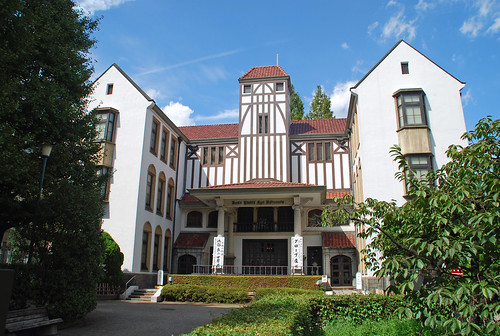

Inside
there are rooms devoted to Shakespeare and the various genres of Japanese theatre
as well as film. I found the most
fascinating room to be the Shoyo Memorial Room, where Dr. Tsubouchi worked
during his lifetime and which contains memorabilia of his life and work. He was born in the year of the sheep and
there are depictions of sheep on the ceiling.
There is also a collection of model sheep on display: “It is said that
he grew very fond of sheep as symbols of ‘bookworms’ who like to read books,
linking to sheep the paper eaters”. Near
the sheep is a collection of small busts of Shakespeare and similar items from
the souvenir shops
of Stratford-upon-Avon.
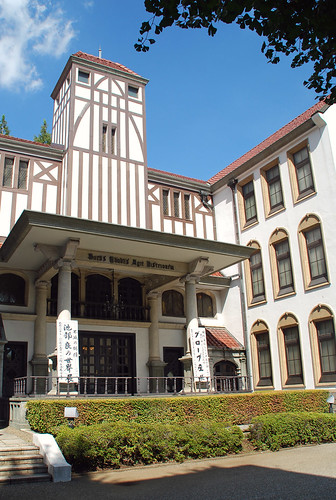
* to reach the picture gallery from this link click on "heritage" on the top bar, then "archive material" then "we have a page..." It does not seem possible to link to the pictures directly.
of Stratford-upon-Avon.

* to reach the picture gallery from this link click on "heritage" on the top bar, then "archive material" then "we have a page..." It does not seem possible to link to the pictures directly.
Most
of the information about The Fortune (and the quote) comes from: Shakespearean
Playhouses A History of English Theatres from the Beginnings to the Restoration
by Joseph Quincy Adams an excellent and thorough account of Elizabethan and
Jacobean theatres which is available at the Gutenberg project and as a free
Kindle book.
